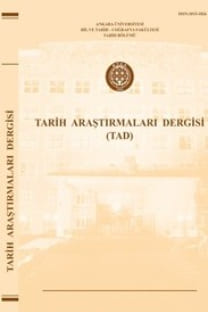TROAS SYNOİKİSİS'İı SYNOECISM IN THE TROAD
Grekçe bir kelime olan Synoikisis fiziki yönüyle ele alındığında genelolarak farklı yerleşimlerden gelen halkların birleşip, yer değiştirerek tek bir yerleşim kurmaları yada aynı bölgede oturan farklı yerleşim halklarının topraklarını birleştinneleri olarak tanımwnır. Yerleşim kurmak yeni bir sosyal-politik yapılanmayı da içediğinden, Synoikisis aynı ,zamanda Antik Grek politikası terminojisinde farklı halkların yönetim düzenlerini birleştirip yeni tek bir yönetici yçuja ortak !?ir.yönetim organı belirlemeleri olarak nitelendirilir. Erken Dönem (/0. 1600-/0.6. yy.) Synoikisisler'inde toprakları ortak savunma,. yerüstü ve yeraltı kaynaklarını ortak kullanma gibi pratik nedenler ön plandayken /0 6. yy ve sonrasında politik nedenler öne çıkmıştır. Hellenistik döneme gelindiğindeyse Synoikisis halkların kendi kararlarıyla yaptıkları bir eylem olmaktan çıkarak Hellenleştirme'ye hizmet eden etkin bir yerleşim politikası haline getiriImiştir. Biz Hellenistik dönem Synp.ikisis'ini Troas'daki örneğiyle ele alarak araştırdık. Söz konusu Troas Synoikisis'i, /0311 yılı Diodokhlar arası büyük barışın hemen sonrasında, Antigonos Monoptalmos tarafindan, bölgenin stratejik noktalarında konumlanmış altı yerleşimin (Kebren, Skepsis, Neandria, Kolonai, Larisa, Hamaksitos) halklarının Aleksandria Troas adlı yeni yerleşime göç ettirilmesiyle gerçekleştirilmiştir.
Anahtar Kelimeler:
TROAS SYNOİKİSİS, SYNOECISM, TROAD
TROAS SYNOİKİSİS'İı SYNOECISM IN THE TROAD
Synoikism, which is a Greek word, is a tenn that is found in the ancient em sett/ement terminolosy. Considering the physical aspects of Synoikism it can be broadly defined as Jolks living in separate settlements joining their land and thus creating a single settlement within the same borders, or folks coming from different settlements joining each other, moving away from their old lands and creating a new settlement on new lands. The concept of settling doesn it only cover physical aspects and costruction, but also social and politieal organizations. With respect, to this Synoikism should also be considered as a concept belonginf{ to the Greek politieal terminology. Seen from this angle, Synoikism can be dejıned as different folks joining their management as one or giving all the managerial power to onererson, in a way centralising their goverment. /n the early period Synoikism's physica needs such as security, joint defense, the search for fertile lands, joining natural resources ete. were the initiators. New social and politieal evolutions were rather results than causes for Synoikism. /n the Helienistic Age, however, Synoikism has changed into a completely new frame, which has moved away from being a self-initiating movement realised by the people and become an efficient and systematic political application sellJing the aim of "Hellenisation ii. In this paper we have exemplified and researched the HelIenistic Synoikism as it existed in Troas. The question why these settlements (Larisa, Kolonai, Hamaxitos, Kebren, Skepsis, Neandria in the Troas) have been chosen for Synoikism has brought to the fore the need to understand Troas historical background until the Hellenistic Period.
Keywords:
TROAS SYNOİKİSİS, SYNOECISM, TROAD,
___
- Demosth. : Demosthenes, Orationes, Thesaurus Linguae Gracae (TLG), CD. Rom, California 1990
- Diod: Diodorus Sicuııus, Bibliotheca Historica, TLG CD Rom, California 1990
- Ephor: Ephoros, Fragmanlar, TLG CD Rom, California 1990
- Hdt.: Herodotos, Historiae, TLG CD Rom, California 1990
- Mela.: Pomponius Mela, De Chorographia, çev. K Brodersen, 1994
- Plut. Alex: Plutarchos, Alexandros, TLG CD Rom, California 1990
- Plut. Theseus: Plutarchos, Theseus, TLG CD Rom, California 1990
- Step. Byz,: Stephanus Byzantius, Ethnika, TLG CD Rom, California 1990
- Strab: Strabon, Geographicon, TLG CD Rom, California 1990
- Thuk.: Thukydides, Historiae, TLG CD Rom, California 1990
- Xen. heıı.: Xenophon, Heııenika, TLG CD Rom, California 1990
- AlA :American Journal of Archeology, New York
- Akalın, Lisans Tezi: Akalın, A.G, Troas Limantepe Larisaısı, AÜ. DTCF-Klasik Arkeoloji Abd., Yayınlanmamış Lisans Tezi, 1988
- Akalın, Y.Lisans Tezi: Akalın, A. G, Troia Bölgesi Skepsj.s ve Hamaksitos Şehirlerinin Tarihi ve Arkeolojik Araştırmalan, AU.Sosyal Bilimler Enstitüsü-Arkeoloji Abd., Yayınlanmamış Y. Lisans Tezi, 1990
- Akalın, Doktora tezi: Akalın, A. G, Trgia Bölgesinde Hellenistik Synoikisis'e değin Sosyal-Politik Gelişim, AU. Sosyal BilimlerEnstitüsü-Tarih Abd., Yayınlanmamış DoktoraTezi, 1999
- AMS: Asia Minor Studien, Bonn
- M. Austin, The Helienistic Worldfrom Alexander to the Ronıan Conquest, 1981
- BCH: Bullettin de Correspondence Hellenique, Paris
- Barclay-Head, Historia Numanorum-A Manual of Greek Numismatics, 1911
- BMC: A catalogue of the Greek Coins in the British Museum, 1873-1927
- BSA : Annual of the British School at Athens, London
- Cook 1973: Cook,J.M The Troad, 1973
- Demand 1990: Demand, N.,Urban Relocation in Archaic and Classical Greece,1990
- Erhardt 1988: Erhardt, N ,Milet und seine Kolonien, 1988
- Gehrke 1986: Gehrke, H.J, Jenseits von Athen und Sparta, 1986, s.34
- Homblower 1982: Homblower, S., Moltsolus, 1982
- JHS : Journal of HeIIenic Studies, London
- Kuhn 1878: Kuhn, E, Staedte der Alten, 1878
- Merrit, D -mc Gregor, F, The Athenian Tribute Lists, 1939-1953
- Meiggs, R. The Athenian Empire, 1987
- Powell, A, Athens and Sparta, 1993
- Schulz, A. Die Stadtmauern von Neandria in der Troas, AMS 38, 2000
- Vermarseren, MJ, Corpus Cultus Cybelae Attidisque, Asia Minor-Mysia et Troade 1987
- Welles, R.C . Royal Correspondenee in the Helienistic Period, 1934
- ZPE : Zeitschrift für Papyrologie und Epigraphik, Stuttgart
- ISSN: 1015-1826
- Yayın Aralığı: Yılda 2 Sayı
- Başlangıç: 1963
- Yayıncı: Levent KAYAPINAR
Sayıdaki Diğer Makaleler
Türkiye Selçuklu-İlhanlı İktisadf, Ticari İlişkileri ve Sonuçları
Sarı Saltık Popüler İslam'ın Balkanlar'daki Destanı Öncüsü (XIII. Yüzyıl)
II. Dünya Savaşında Türkiye'de Askeri Mülteciler ve Gözaltı Kampları (1941-1942)
TROAS SYNOİKİSİS'İı SYNOECISM IN THE TROAD
Eskiçağda Grek Kadının Toplumsal Yaşantısı
İlk Tunç çağı'nın Son Evresinde Anadolu'nun Siyasal Görünümü
Eski Türk İnancı Üzerine Bir Özet
Osmanlı İmparatorluğu'nda Seyahat İzinleri (18-19.Yüzyıl)
OSMANLI DÖNEMİNDE İMAMLAR VE BİR IMAMIN GUNLUGU
